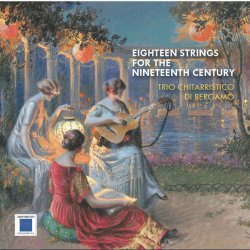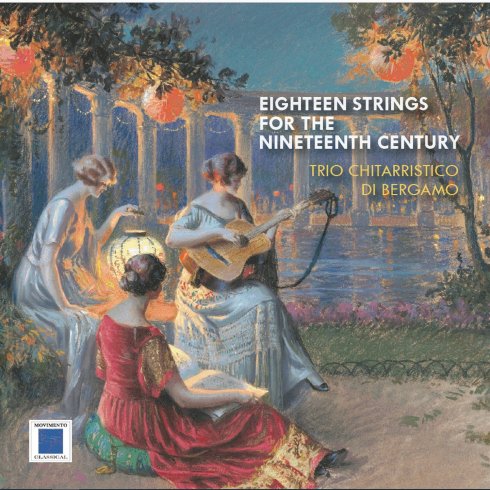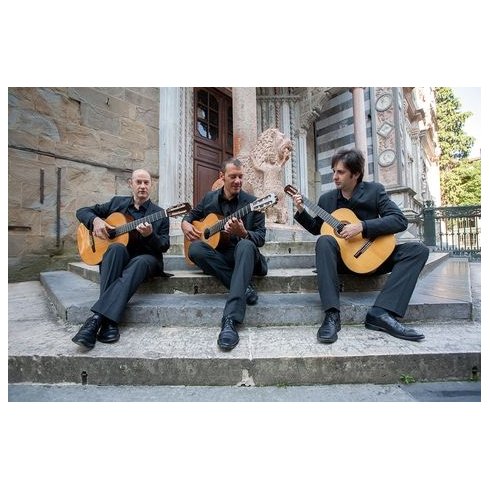

Eighteen Strings for the Nineteenth Century
Within the framework of the 18th century literature for guitar trios, which is not vast, the aim of this record was to select five works that, to our knowledge, can well represent the repertoire of that period, in terms of both the relevance of their composers and their stylistic diversity, reflecting three distinct cultural areas. To the classic trios by Diabelli, Gragnani and Lhoyer, apices of the Austrian, Italian and French productions, respectively, we added the most important romantic work, namely Zani De Ferranti’s Polonaise Concertante, which is often present in the set-lists of the most renowned trios. We further extended our selection to include Varlet’s Petit Trio, an intriguing, though less celebrated piece, composed by a little known author. It shows evidence of both refined composition skills and rich melodic inventiveness, which can compare to those of the other pieces included in this record. Anton Diabelli’s Gran Trio op. 62 is a very ambitious work, both in terms of duration (four movements, the first one remarkably long) and for the attempt to take full advantage of the different ranges covered by three similar instruments. In fact, in order to obtain different kinds of tuning, the author recommends the use of sordino on the first two guitars, in correspondence of the fifth and of the third fret respectively. The first move ment is opened by an Adagio in F major (which is the leading key in all the movements), followed by an Allegro moderato, where the two themes, handled almost exclusively by the first guitar, are continuously rearranged and developed to reach a higher intensity. The following Minuetto, martial at times, though apparently con ventional, manages to highlight the interplay between instruments, mainly in the trio in C major. The Rondò that follows reveals even stronger composition skills. It represents the climax of the whole trio and leads to an unexpected final movement (Marcia), which makes for a triumphal ending. Unlike Diabelli’s trio, where a north-european proclivity for thematic development emerges, in his Trio op. 12 in D major, Filippo Gragnani shows a typically Italian taste for melody. The importance of this trio lies in the composer’s ability to exploit three identical instruments to highlight their timbric and acoustic potential. This aspect is especially evident when the two first guitars repeatedly interact in parallel thirds in the first and third (Minuetto in D major) movements, creating a remarkably layered sound, which reflects the playful and unsophisticated tone of the melodic line. The central Andante con variazioni in A major differs with respect to the melody, which reminds of atypically opera theme from the end of the 18th century. Antoine de Lhoyer devoted most of his career to the composition of chamber music for guitar. He composed two significant works for guitar trios, similar to each other both in terms of style and for the pronounced Vien nese taste: the Trio Concertante per tre chitarre op. 29 and the Secondo Trio per tre chitarre op. 42. The Trio op. 29, which is more renowned and more frequently played nowadays, contains gentle and well-balanced gallant themes, which are developed at a virtuoso level, especially by the first guitar. This aspect emerges in the first movement in G major in sonata form, predominantly within the sections where the main theme is unfolded, like in the Adagio in A major and in the virtuoso crescendo of the final Andante con variazioni in the initial key. Only the Minuetto con Trio in E minor unfolds in a plainer way, with a gallant theme played by the first instru ment, often supported by simple chords from the other two guitars. Lyon-born Varlet’s Petit trio por trois guitares opens with a solemn theme. An introductory motto is fol lowed by a flowing melody handled by the first guitar in the main key (A major) and then by the majes tic main theme, which is unfolded by the interplay between the first and the third instrument twice, in A major and B-flat major respectively. The theme of the following movement, in A major, appears to be extremely simple, allowing for a strong and peculiar characterization of the variations that follow, whereas the final Allegro, consisting of three parts in rondo form, is linked to the introduction by an explicit ref erence, namely the adaptation of the main theme in valzer form. The interplay between the three instru ments based on imitation makes the coda extremely powerful. The final crescendo might remind of Ross ini’s music. Most of Bologna-born virtuoso Zani de Ferranti’s output is aimed to a renovation of the composition style for guitar, from both a technical and an idi omatic angle. Nevertheless, his research as a virtuoso of the instrument is often matched by his pursuit for melodic invention. The Polonaise concertante op. 27 is a clear example of his ability to merge the two aforementioned aspects smoothly. The introductory Largo opens with a motto, which serves as a preamble to a melodic interplay between the first and the third guitar, in correspondence of which an A-major key is progressively defined. The following section (Allegro non troppo) stands in stark contrast to the one that precedes it; opera-inspired repeated chords in conci tato style played by the first guitar support the restless interplay based on imitation of the other two instru ments. The sweet and melancholy opening tone of the actual Polonaise is at odds with the preceding section and it is highlighted by a Neapolitan-flavored melody in A minor. It is followed by a sequence of themes, the structures of which consist of regular phrases and periods. These are repeatedly played by the three instruments in a sequence and they are often termi nated with sudden changes to adjacent keys. As far as themes are concerned, singable instances of monody are interleaved with virtuoso-like parts, which are of ten based on imitation between different parts. Sev eral major keys are reached before the initial theme is reintroduced twice at the end of the composition, bringing it to an end and, at the same time, complet ing its symmetric structure.


TRIO CHITARRISTICO DI BERGAMO
Born in August 2008 from the idea of three musicians : Luca Bertocchi, Marco Monzio Compagnoni and Mario Rota. This new artistic project was born with the aim of disclosing the specific repertoire for guitar trio. The Trio Chitarristico of Bergamo has followed specialization courses held by Giulio Tampalini.
In the spring of 2009 the trio has obtained precious acknowledgments by winning the second prize in the national competitions "G. Rospigliosi" of Lamporecchio (Pistoia) and "Ansaldi-Servetti-Tomatis" of Mondovì (Cuneo). In 2011 the trio won the first overall prize at the " Città di Voghera" competition. In their repertoire and in numerous concerts they propose a natural path consisting of a program ranging from the Baroque period to the present day; including transcriptions from piano operas and music scores for various orchestral ensembles, but above all original songs written specifically for this ensemble. Lately the trio has been deepening the study of music by contemporary Italian authors, generating the interest of many musicians who have composed songs specifically for the Bergamo-based band. The intent of the proposed record is to establish and disclose a considerable part of this project.
